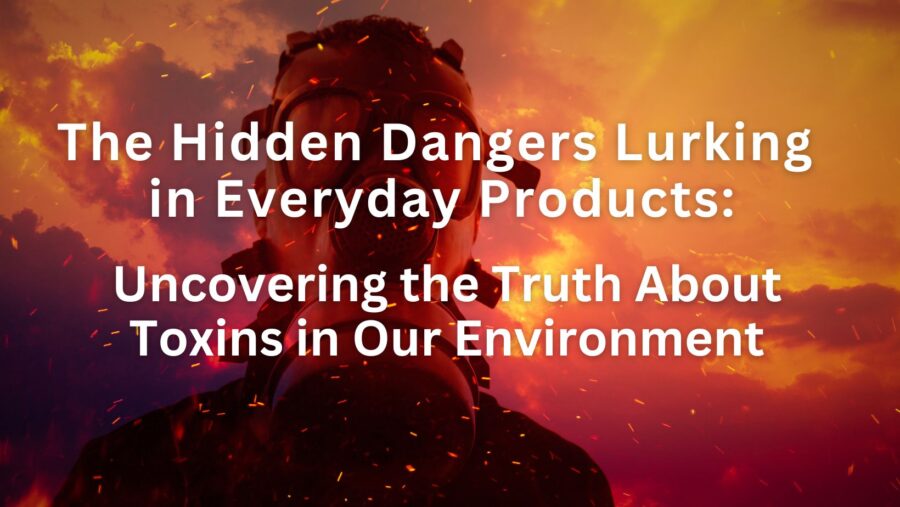Toxins in Everyday Products: Uncovering the Hidden Dangers
Healthful Vitality | 03/30/2023 | Toxins in Everyday Products: Uncovering the Hidden Dangers.

Every day, we are exposed to countless products and materials that we assume are safe to use. However, many of these everyday items contain harmful chemicals and toxins that can seriously affect our health. In this article, Toxins in Everyday Products: Uncovering the Hidden Dangers, we will explore some of the hidden dangers that may be lurking in the products we use and the environment around us.
Contents
I. Understanding Toxins and Their Effects
- What are toxins?
- How do they affect our health?
II. Common Toxins in Everyday Products
- Chemicals in cleaning products
- Harmful ingredients in personal care products
- Toxins in food and packaging
III. Environmental Toxins
- Air pollution and its effects
- Water contamination
- Pesticides and other toxins in our food supply
IV. Steps to Minimize Exposure
- Choosing safer products
- Eating a healthy diet
- Reducing environmental pollution
V. Conclusion: Taking Control of Your Health
I. Understanding Toxins and Their Effects
Toxins are substances that can cause harm to living organisms. They can come from a variety of sources, including industrial pollution, pesticides, and chemicals in consumer products. Exposure to toxins can have a range of negative effects on our health, including damage to our organs, disruption of our hormones, and an increased risk of cancer and other diseases.
II. Common Toxins in Everyday Products
Many common household products contain harmful chemicals that we may not even be aware of. For example, cleaning products often contain bleach, ammonia, and other harsh chemicals that can cause respiratory problems and skin irritation. Personal care products such as shampoos, lotions, and makeup often contain parabens and other potentially harmful ingredients. Even the food we eat and its packaging can contain toxins such as BPA and phthalates.
III. Environmental Toxins
Toxins in our environment can also have a significant impact on our health. Air pollution, for example, can exacerbate respiratory problems and increase the risk of heart disease and other illnesses. Water contamination can also be a major source of toxins, especially in areas with poor infrastructure or industrial activity. Pesticides used in agriculture can also contaminate our food supply, leading to increased risk of cancer and other health problems.
IV. Steps to Minimize Exposure
While it’s impossible to avoid toxins in our environment completely, there are steps we can take to minimize our exposure. For example, choosing safer products, such as those labeled as “organic” or “non-toxic,” can help reduce our exposure to harmful chemicals. Eating a healthy diet that focuses on whole, unprocessed foods can also help limit our intake of toxins from food. And working to reduce environmental pollution through advocacy and lifestyle changes can help protect us and future generations from the harmful effects of toxins.
V. Conclusion: Taking Control of Your Health
By becoming more aware of the hidden dangers in our environment and taking steps to minimize our exposure, we can take control of our health and reduce our risk of illness and disease. By choosing safer products, eating a healthy diet, and working to reduce environmental pollution, we can create a safer, healthier world for ourselves and future generations.
Here are some takeaway points from the article:
- Toxins are substances that can cause harm to living organisms and are found in many everyday products and the environment around us.
- Exposure to toxins can negatively affect our health, including damage to our organs, disruption of our hormones, and an increased risk of cancer and other diseases.
- Common toxins in everyday products include chemicals in cleaning products, harmful ingredients in personal care products, and toxins in food and packaging.
- Environmental toxins can come from air pollution, water contamination, and pesticides used in agriculture.
- Minimizing our exposure to toxins includes choosing safer products, eating a healthy diet, and advocating for environmental policies promoting cleaner air and water.
- By taking control of our own health and working together to create a healthier future, we can reduce our community’s exposure to harmful toxins.
Related Articles:
The Impact of Climate Change on Nutrition: Why it Matters for our Health
Using Urban Architecture to Build Health-Friendly Living Environments
